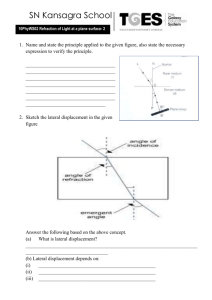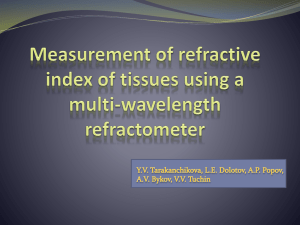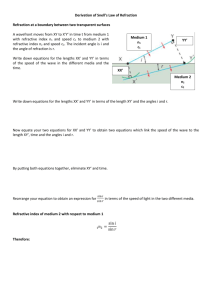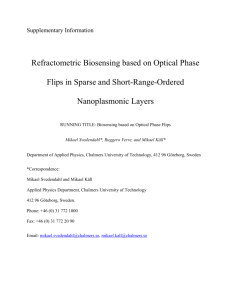Readme file
advertisement
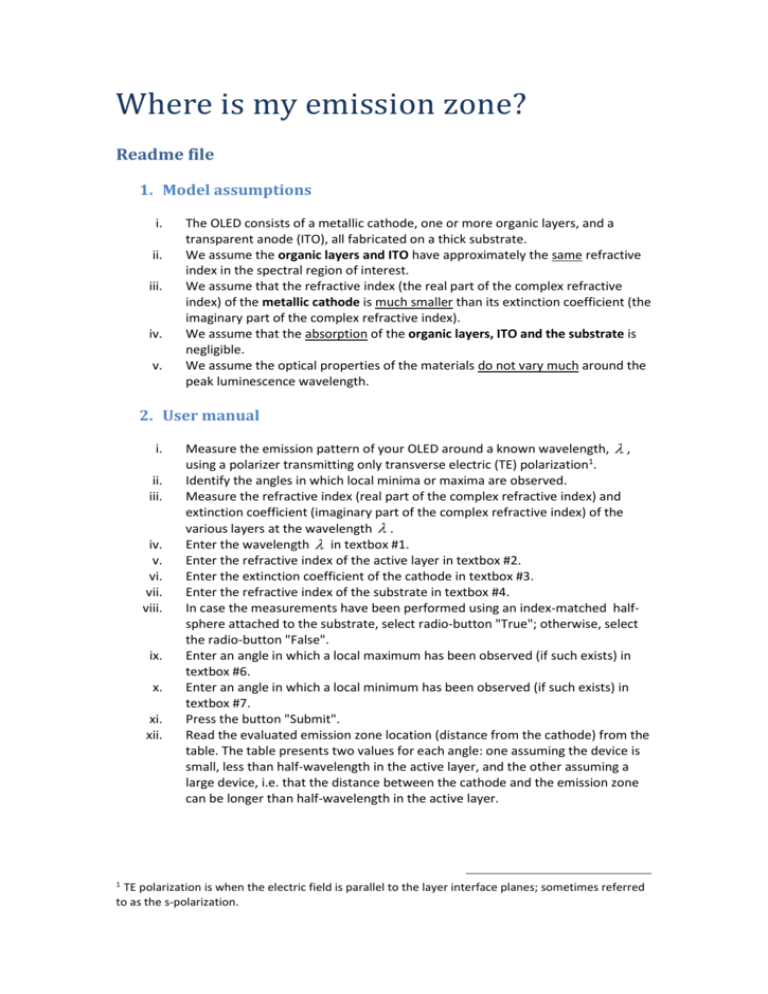
Where is my emission zone? Readme file 1. Model assumptions i. ii. iii. iv. v. The OLED consists of a metallic cathode, one or more organic layers, and a transparent anode (ITO), all fabricated on a thick substrate. We assume the organic layers and ITO have approximately the same refractive index in the spectral region of interest. We assume that the refractive index (the real part of the complex refractive index) of the metallic cathode is much smaller than its extinction coefficient (the imaginary part of the complex refractive index). We assume that the absorption of the organic layers, ITO and the substrate is negligible. We assume the optical properties of the materials do not vary much around the peak luminescence wavelength. 2. User manual i. ii. iii. iv. v. vi. vii. viii. ix. x. xi. xii. 1 Measure the emission pattern of your OLED around a known wavelength, , using a polarizer transmitting only transverse electric (TE) polarization1. Identify the angles in which local minima or maxima are observed. Measure the refractive index (real part of the complex refractive index) and extinction coefficient (imaginary part of the complex refractive index) of the various layers at the wavelength . Enter the wavelength in textbox #1. Enter the refractive index of the active layer in textbox #2. Enter the extinction coefficient of the cathode in textbox #3. Enter the refractive index of the substrate in textbox #4. In case the measurements have been performed using an index-matched halfsphere attached to the substrate, select radio-button "True"; otherwise, select the radio-button "False". Enter an angle in which a local maximum has been observed (if such exists) in textbox #6. Enter an angle in which a local minimum has been observed (if such exists) in textbox #7. Press the button "Submit". Read the evaluated emission zone location (distance from the cathode) from the table. The table presents two values for each angle: one assuming the device is small, less than half-wavelength in the active layer, and the other assuming a large device, i.e. that the distance between the cathode and the emission zone can be longer than half-wavelength in the active layer. TE polarization is when the electric field is parallel to the layer interface planes; sometimes referred to as the s-polarization. 3. Example We consider the device by Mladenovski, et al., "Exceptionally efficient organic light emitting devices using high refractive index substrates," Opt. Express 17, 7562-7570 (2009) (open access journal). The OLED stack measured therein has the structure Silver/Organic/ITO/Glass, and the measurements where conducted using an index-matched half-sphere (Section 3 therein). We note the dominant wavelength in the electroluminescence spectrum is 530nm (Subsection 4.1 therein), the refractive index of the organic layers is ~1.8 (Section 1 therein), the extinction coefficient of the cathode is ~3.25 in that wavelength (optical handbooks), and the substrate refractive index is 1.5 (Section 1 therein). Fig. 4(c) therein exhibits a maximum around 30°. According to the authors, this correspond to a separation of ~230nm between the emission zone and the cathode. Now we enter the data we have gathered to the applet: and the evaluated emission zone location is 221nm, suitable for a large device. 4. References The applet is based on the model presented and demonstrated in [1] A. Epstein, N. Tessler, and P. Einziger, "Analytical extraction of the recombination zone location in organic light-emitting diodes from emission pattern extrema," Opt. Lett. 35, 3366-3368 (2010). The method was recently augmented to treat more general OLED structures, as presented in International Conference on Simulation of Organic Electronics and Photonics (SimOEP2012), and is now in preperation.
